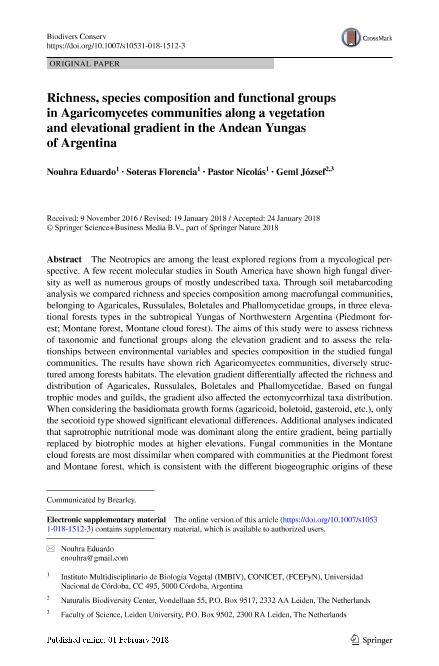Mostrar el registro sencillo del ítem
dc.contributor.author
Nouhra, Eduardo Ramon

dc.contributor.author
Soteras, María Florencia

dc.contributor.author
Pastor, Nicolás

dc.contributor.author
Geml, József

dc.date.available
2019-11-04T16:37:24Z
dc.date.issued
2018-07
dc.identifier.citation
Nouhra, Eduardo Ramon; Soteras, María Florencia; Pastor, Nicolás; Geml, József; Richness, species composition and functional groups in Agaricomycetes communities along a vegetation and elevational gradient in the Andean Yungas of Argentina; Springer; Biodiversity and Conservation; 27; 8; 7-2018; 1849-1871
dc.identifier.issn
0960-3115
dc.identifier.uri
http://hdl.handle.net/11336/87896
dc.description.abstract
The Neotropics are among the least explored regions from a mycological perspective. A few recent molecular studies in South America have shown high fungal diversity as well as numerous groups of mostly undescribed taxa. Through soil metabarcoding analysis we compared richness and species composition among macrofungal communities, belonging to Agaricales, Russulales, Boletales and Phallomycetidae groups, in three elevational forests types in the subtropical Yungas of Northwestern Argentina (Piedmont forest; Montane forest, Montane cloud forest). The aims of this study were to assess richness of taxonomic and functional groups along the elevation gradient and to assess the relationships between environmental variables and species composition in the studied fungal communities. The results have shown rich Agaricomycetes communities, diversely structured among forests habitats. The elevation gradient differentially affected the richness and distribution of Agaricales, Russulales, Boletales and Phallomycetidae. Based on fungal trophic modes and guilds, the gradient also affected the ectomycorrhizal taxa distribution. When considering the basidiomata growth forms (agaricoid, boletoid, gasteroid, etc.), only the secotioid type showed significant elevational differences. Additional analyses indicated that saprotrophic nutritional mode was dominant along the entire gradient, being partially replaced by biotrophic modes at higher elevations. Fungal communities in the Montane cloud forests are most dissimilar when compared with communities at the Piedmont forest and Montane forest, which is consistent with the different biogeographic origins of these forests. DNA metabarcoding sequence analysis provided detailed information on the diversity and taxonomic and functional composition of macrofungal communities.
dc.format
application/pdf
dc.language.iso
eng
dc.publisher
Springer

dc.rights
info:eu-repo/semantics/openAccess
dc.rights.uri
https://creativecommons.org/licenses/by-nc-sa/2.5/ar/
dc.subject
ELEVATIONAL GRADIENT
dc.subject
FUNCTIONAL GROUPS
dc.subject
FUNGAL COMMUNITIES
dc.subject
MACROMYCETES
dc.subject
NEOTROPICS
dc.subject.classification
Micología

dc.subject.classification
Ciencias Biológicas

dc.subject.classification
CIENCIAS NATURALES Y EXACTAS

dc.title
Richness, species composition and functional groups in Agaricomycetes communities along a vegetation and elevational gradient in the Andean Yungas of Argentina
dc.type
info:eu-repo/semantics/article
dc.type
info:ar-repo/semantics/artículo
dc.type
info:eu-repo/semantics/publishedVersion
dc.date.updated
2019-10-23T21:35:54Z
dc.identifier.eissn
1572-9710
dc.journal.volume
27
dc.journal.number
8
dc.journal.pagination
1849-1871
dc.journal.pais
Alemania

dc.description.fil
Fil: Nouhra, Eduardo Ramon. Universidad Nacional de Córdoba; Argentina. Consejo Nacional de Investigaciones Científicas y Técnicas. Centro Científico Tecnológico Conicet - Córdoba. Instituto Multidisciplinario de Biología Vegetal. Universidad Nacional de Córdoba. Facultad de Ciencias Exactas Físicas y Naturales. Instituto Multidisciplinario de Biología Vegetal; Argentina
dc.description.fil
Fil: Soteras, María Florencia. Consejo Nacional de Investigaciones Científicas y Técnicas. Centro Científico Tecnológico Conicet - Córdoba. Instituto Multidisciplinario de Biología Vegetal. Universidad Nacional de Córdoba. Facultad de Ciencias Exactas Físicas y Naturales. Instituto Multidisciplinario de Biología Vegetal; Argentina
dc.description.fil
Fil: Pastor, Nicolás. Consejo Nacional de Investigaciones Científicas y Técnicas. Centro Científico Tecnológico Conicet - Córdoba. Instituto Multidisciplinario de Biología Vegetal. Universidad Nacional de Córdoba. Facultad de Ciencias Exactas Físicas y Naturales. Instituto Multidisciplinario de Biología Vegetal; Argentina
dc.description.fil
Fil: Geml, József. Leiden University; Países Bajos
dc.journal.title
Biodiversity and Conservation

dc.relation.alternativeid
info:eu-repo/semantics/altIdentifier/url/http://link.springer.com/10.1007/s10531-018-1512-3
dc.relation.alternativeid
info:eu-repo/semantics/altIdentifier/doi/https://doi.org/10.1007/s10531-018-1512-3
Archivos asociados
